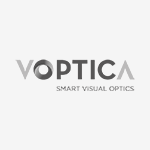Some of the different currently applied approaches that correct presbyopia may reduce stereovision. In this work, stereo-acuity was measured for two methods: (1) monovision and (2) small aperture inlay in one eye. When performing the experiment, a prototype of a binocular adaptive optics vision analyzer was employed. The system allowed simultaneous measurement and manipulation of the optics in both eyes of a subject. The apparatus incorporated two programmable spatial light modulators: one phase-only device using liquid crystal on silicon technology for wavefront manipulation and one intensity modulator for controlling the exit pupils. The prototype was also equipped with a stimulus generator for creating retinal disparity based on two micro-displays. The three-needle test was programmed for characterizing stereo-acuity. Subjects underwent a two-alternative forced-choice test. The following cases were tested for the stimulus placed at distance: (a) natural vision; (b) 1.5 D monovision; (c) 0.75 D monovision; (d) natural vision and small pupil; (e) 0.75 D monovision and small pupil. In all cases the standard pupil diameter was 4 mm and the small pupil diameter was 1.6 mm. The use of a small aperture significantly reduced the negative impact of monovision on stereopsis. The results of the experiment suggest that combining micromonovision with a small aperture, which is currently being implemented as a corneal inlay, can yield values of stereoacuity close to those attained under normal binocular vision.
Search
Categories
Archives
- July 2024 (8)
- June 2024 (1)
- October 2023 (2)
- July 2023 (5)
- June 2023 (1)
- July 2022 (10)
- July 2021 (5)
- March 2021 (2)
- October 2020 (36)
- September 2020 (122)
- August 2020 (10)
- July 2020 (38)
- April 2020 (1)
- April 2018 (1)
- September 2017 (2)

Impact on stereo-acuity of two presbyopia correction approaches: monovision and small aperture inlay
- Voptica
- VAO Publications
Journal:
Biomedical Optics Express
Year:
2013
Link:
Authors:
Enrique Josua Fernández; Christina Schwarz; Pedro M. Prieto; Silvestre Manzanera; Pablo Artal

